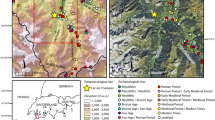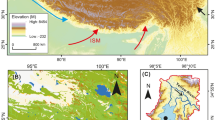Abstract
Pollen spectra from seven short cores taken from deltaic sites in the central and northern parts of Lake Tanganyika provide information about vegetation changes around the lake during the last 5000 years. Pollen analysis was undertaken to understand the history and timing of catchment deforestation and its causal linkage to excess sedimentation and ecosystem change in Lake Tanganyika. The spectra are dominated by grass pollen at all levels in every core. Grass pollen percentage values range between 40 and 80%. Low values of arboreal pollen taxa (1–20%) were documented from most cores except core LT-98-2M. Core LT-98-2M represents the longest duration vegetation record of this study (close to 5000 years BP), and records the onset of increasingly arid conditions in the Late Holocene, especially after ∼500 A.D., with the probable replacement of forest by open grassland in the Mahale Mountains region. The pollen/spore content for other cores showed a consistent trend of a decrease in grass pollen and an increase in pteridophyte and forest indicator pollen taxa during the last few centuries, contemporaneous with other indications of increased watershed disturbance from forest clearing (especially isotopes and lake faunal change). The timing or strength of this trend is not tied to specific levels of watershed disturbance. However, increasing fern spore abundance does occur progressively later towards the south, where modern human population densities are lower. Although increasing fern spore abundance is consistent with a land-clearing hypothesis, the rising arboreal pollen percentages are seemingly counterintuitive. One possible explanation is that increasing arboreal pollen proportions reflects the recycling of abundant pollen of this type from rapidly eroding soils. Another likely explanation for this finding is that land clearing involved the replacement of miombo woodland, with its mixture of trees producing little pollen and understory grasses producing large amounts of pollen, by the present day cassava, banana, and legume agricultural systems, all of which are poor pollen producers. This shift in catchment vegetation would increase the relative contribution of Afromontane pollen transported long distances from the surrounding highland regions. This hypothesis is consistent with both the lack of correlation of palynological history with specific watershed deforestation attributes, as well as the broader historical record of human habitation in the Lake Tanganyika region. This study also highlights the need for both modern pollen transect data from the region and comparative cores from low elevation swamps or ponds (wetlands) in the region with smaller catchment areas.
Similar content being viewed by others
References
S.R. Alin A.S. Cohen (2003) ArticleTitleLake-level history of Lake TanganyikaEast Africafor the past 2500 years based on ostracode-inferred water depth reconstruction Palaeogeogr. Palaeoclim. Palaeoecol. 199 31–49 Occurrence Handle10.1016/S0031-0182(03)00484-X
Bygott D. 1992. Gombe Stream National Park. Tanzania National Parks and African Wildlife Foundation, 71 pp.
T.H. Clutton-Brock J.B. Gillett (1979) ArticleTitleA survey of forest composition in the Gombe National Park, Tanzania Afr. J. Ecol. 17 131–158
Cohen A.S., Palacios-Fest M.R., McGill J., Swarzwenski P., Verschuren D., Sinyinza R., Songori T., Kakagozo B., Syampila M. and O’Reilly C. 2005a. Paleolimnological investigations of anthropogenic environmental change in Lake Tanganyika: I. An introduction to the project. J. Paleolimnol. 34: 1–18.
Cohen A.S., Palacios-Fest M.R., Msaky E.S., Alin S.R., McKee B., O’Reilly C.M., Dettman D.L., Nkotagu H.H. and Lezzar K.E. 2005b. Paleolimnological Investigations of Anthropogenic Environmental Change in Lake Tanganyika: IX. Summary of paleorecords of environmental change and catchment deforestation at Lake Tanganyika and impacts on the Lake Tanganyika ecosystem. J. Paleolimnol. 34: 125–145.
G.H. DeBusk (1997) ArticleTitleThe distribution of pollen in the surface sediments of Lake MalawiAfricaand the transport of pollen in large lakes Rev. Paleobot. Palynol. 97 123–153 Occurrence Handle10.1016/S0034-6667(96)00066-8
G.H. DeBusk (1998) ArticleTitleA 37,000 year pollen record from Lake Malawi and implications for the biogeography of afromontane forest J. Biogeogr. 25 479–500 Occurrence Handle10.1046/j.1365-2699.1998.2530479.x
F.N. Hepper (Eds) (1963) Flora of West Tropical Africa2nd ed., vol. II Crown Agents for Overseas Governments and Administration (NigeriaGhanaSierra Leoneand Gambia) London
F.N. Hepper (Eds) (1968) Flora of West Tropical Africa2nd ed., vol. III, Part 1 Crown Agents for Overseas Governments and Administration (NigeriaGhanaSierra Leone and Gambia) London
P.R.O. Kio (1982) Forest conservation strategies for tropical AfricaChapter 7 L. MacDonald (Eds) Agro-forestry in the African Humid Tropics United Nations University TokyoJapan
McKee B., Cohen A.S., Dettman D.L., Palacios-Fest M.R., Alin S.R. and Ntungumburanye G. 2005. Paleolimnological investigations of anthropogenic change in Lake Tanganyika: II. Geochronologies and mass sedimentation rates based on 14C and 210Pb data. J. Paleolimnol. 34: 19–29.
O’Reilly C.M., Dettman D.L. and Cohen A.S. 2005. Paleolimnological investigations of anthropogenic environmental change in Lake Tanganyika: VI. Geochemical indicators from lacustrine organic matter. J. Paleolimnol. 34: 85–91.
Palacios-Fest M.R., Alin S.R., Cohen A.S., Tanner B. and Heuser H. 2005a. Paleolimnological investigations of anthropogenic environmental change in Lake Tanganyika: IV. Lascustrine paleoecology. J. Paleolimnol. 34: 51–71.
Palacios-Fest M.R., Cohen A.S., Lezzar K.E., Nahimana L. and Tanner B.M. 2005b. Paleolimnological investigations of anthropogenic environmental change in Lake Tanganyika: III. Physical stratigraphy and charcoal analysis. J. Paleolimnol. 34: 31–49.
S.M. Peglar H.H. Birks H.J.B. Birks (2001) ArticleTitleTerrestrial pollen record of recent land-use changes around nine North African lakes in the CASSARINI Project Aquat. Ecol. 35 431–448 Occurrence Handle10.1023/A:1011988127627
R.M Polhill (Eds) (1982) Flora of Tropical East Africa. Gramineae (part 3) A.A. Balkema Rotterdam 155
R.M Polhill (Eds) (1987) Flora of Tropical East Africa: Euphorbiaceae(part 1) A.A. Balkema Rotterdam 407
G.V. Pope (Eds) (1960) Flora Zambesiaca. Introduction, CycadaceaePodocarpaceaeCupressaceae. Ranunculaceae – Polygonaceae. Vol. 1, Part 1 Royal Bot. Gardens, Kew London 336
G.V. Pope (Eds) (1961) Flora Zambesiaca. Caryophyllaceae – Sterculiaceae. Vol. 1, Part 2 Royal Bot. Gardens Kew, London 245
G.V. Pope (Eds) (1963) Flora Zambesiaca. Tiliaceae – IcacinaceaeVol. 2, Part 1 Royal Bot. Gardens Kew, London 351
G.V. Pope (Eds) (1966) Flora Zambesiaca. Aquifoliaceae – ConnaraceaeVol. 2, Part 2 Royal Bot. Gardens Kew, London 300
G.V. Pope (Eds) (1970) Flora ZambesiacaLeguminosaesubfamily MimosoideaeVol. 3. Part 1 Royal Bot. Gardens Kew, London 153
G.V. Pope (Eds) (1971) Flora ZambesiacaGramineae (Bambuseae - Pappophoreae), Vol. 10, Part 1 Royal Bot. Gardens Kew, London 152
G.V. Pope (Eds) (1978) Flora ZambesiacaRosaceae - Cornaceae (excl. Escalloniaceae and Crassulaceae), Vol. 4 Royal Bot. Gardens Kew, London 658
G.V. Pope (Eds) (1983) Flora ZambesiacaEscalloniaceaeCrassulaceaeValerianaceaeDipsacaceae and Goodeniaceae – SalvadoraceaeVol. 7, Part 1 Royal Bot. Gardens Kew, London 394
G.V. Pope (Eds) (1985) Flora Zambesiaca. Apocynaceae Vol. 7, Part 2 Royal Bot. Gardens Kew, London 108
G.V. Pope (Eds) (1987) Flora ZambesiacaConvolvulaceae – CuscutaceaeVol. 8, Part 1 Royal Bot. Gardens Kew, London 142
G.V. Pope (Eds) (1988) Flora ZambesiacaRubiaceaesubfamily Rubioideae Vol. 4, Part 1 Royal Bot. Gardens Kew, London 250
G.V. Pope (Eds) (1989) Flora ZambesiacaGramineae (PaniceaeIsachneae and Arundinelleae), Vol. 10, Part 3 Royal Bot. Gardens Kew, London 231
G.V. Pope (Eds) (1990) Flora ZambesiacaCanellaceae – BoraginaceaeVol. 7, Part 4 Royal Bot. Gardens Kew, London 114
G.V. Pope (Eds) (1991) Flora ZambesiacaUlmaceae – Ceratophyllaceae (excluding Myricaceae), Vol. 9, Part 6 Royal Bot. Gardens Kew, London 135
G.V. Pope (Eds) (1992) Flora ZambesiacaCompositaeTribes MutisieaeCardueaeVernonieaeLactuceaeArctotideae Vol 6 Part 1 Royal Bot. Gardens Kew, London 264
G.V. Pope (Eds) (1993) Flora Zambesiaca IridaceaeVol. 12, Part 4 Royal Bot. Gardens Kew 106
G.V. Pope (Eds) (1995) Flora ZambesiacaOrchidaceaeVol. 11, Part 1 Royal Bot. Gardens Kew, London 328
Verschuren D. 2004. Decadal and century-scale climate variability in tropical Africa during the past 2000 years. In:␣Battarbee R.W., Gasse F. and Stickley C. eds., Past Climate Variability through Europe and Africa. Developments in Paleoenvironmental Research. Vol. 6. SpringerDordrecht.
D. Verschuren K.R. Laird B.F. Cumming (2000) ArticleTitleRainfall and drought in equatorial east Africa during the past 1100 years Nature 403 410–414 Occurrence Handle10.1038/35000179 Occurrence Handle1:CAS:528:DC%2BD3cXps1egtA%3D%3D Occurrence Handle10667789
A. Vincens (1991) ArticleTitleLate quaternary vegetational history of the south-Tanganyika basin. Climatic implications in south-central Africa Palaeogeogr. Palaeoclim. Palaeoecol. 86 207–226 Occurrence Handle10.1016/0031-0182(91)90081-2
A. Vincens (1993) ArticleTitleNouvelle sequence pollinique du lac Tanganyika. 30,000 ans d’histoire botanique et climatique du bassin Nord Rev. Paleobot. Palynol. 78 381–394
Author information
Authors and Affiliations
Corresponding author
Rights and permissions
About this article
Cite this article
Msaky, E.S., Livingstone, D. & Davis, O.K. Paleolimnological investigations of anthropogenic environmental change in Lake Tanganyika: V. Palynological evidence for deforestation and increased erosion. J Paleolimnol 34, 73–83 (2005). https://doi.org/10.1007/s10933-005-2398-0
Received:
Accepted:
Issue Date:
DOI: https://doi.org/10.1007/s10933-005-2398-0




